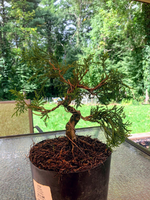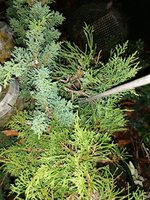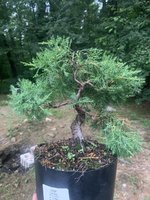Balbs
Shohin
I'm going to document the progression of an Old Gold Juniper in this thread. After staring at it for a year and a half, I think I understand why there are so few threads on this cultivar on here. Anyhow, July of 2019 I came across this tree at a local HD and I liked the trunk and what I could see of the basal flare, so for the 11.98, I gambled. My apologies in advance for the poor picture taking. I really do have to get better about this. So here it is, last july: 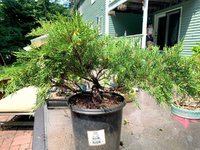
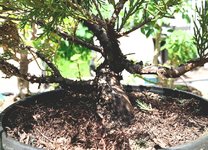
About a month later, with little idea how to proceed and a glass (or two-ish) of wine to give me courage, I started cutting branches, wiring and lowering branches, etc.

I hate it, but, I had no idea why. I decided the tree had taken enough of a beating and I just left it alone. So, at the advice of this forum, I bought Principles of Bonsai Design by DeGroot, and read, and studied the tree, and thought, and made sketches, all winter. I wish I had taken pictures, but I drew the tree, measured each segment, and considered it relative to the Fibonacci sequence. I didn't know how to move forward, but the good news was that I figured out what was wrong with it. The lower trunk is stout, has good movement and slight taper (tough to really see in the pictures) but the second trunk section is straight, has little taper, disobeys Fibonacci in length, among other things. The tree was too tall and slender, the line sort of feminine. This wouldn't be an issue on its own, but it doesn't match the first three inches of the tree. It has bar branches. The overall silhouette's triangular shape looks like a Christmas tree.
Fast forward a year later, now it's the end of July of 2020. I'm tired of the COVID monotony, spending a ton of time outside, staring at this tree, and I decided to give it hell. Chop.

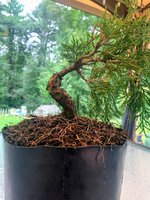

Wire. Poor skill, I know. I'm learning.
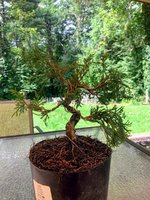
I think the image above is the best front. The chop gave me better taper, better proportions, etc. The biggest issue is the coarseness/lack of compactness of the foliage. But that's just the cultivar, I think.
So, today, 11/25, I did some wiring. And I was careful. It's not perfect, and I made tons of mistakes, but not for lack of trying. So I'm proud of the work anyway. This week I also came across Smoke's thread about stick figure drawing. This morning I went through the exercise and it really was helpful and eye opening. With that in mind, I moved some of the branches around to create a better overall shape. I wish I had a before picture, but I don't. Here's the result:
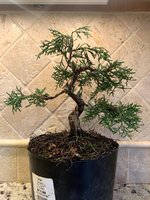
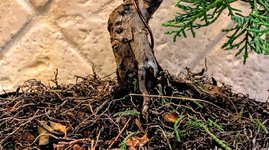
And, you know what? I don't hate it anymore. I won't say I love it. The foliage is long and saggy and I'll never change that. But, I'm proud of the work and the progress, and what this tree has pushed me to learn about bonsai through my research. It has some juvenile foliage, and I know I'm pressing my luck, so now I really have to ward off my impatience and leave the damn thing alone.
Happy to take suggestions if you have them.
If you made it through this length post, thanks for reading!
-Marc


About a month later, with little idea how to proceed and a glass (or two-ish) of wine to give me courage, I started cutting branches, wiring and lowering branches, etc.

I hate it, but, I had no idea why. I decided the tree had taken enough of a beating and I just left it alone. So, at the advice of this forum, I bought Principles of Bonsai Design by DeGroot, and read, and studied the tree, and thought, and made sketches, all winter. I wish I had taken pictures, but I drew the tree, measured each segment, and considered it relative to the Fibonacci sequence. I didn't know how to move forward, but the good news was that I figured out what was wrong with it. The lower trunk is stout, has good movement and slight taper (tough to really see in the pictures) but the second trunk section is straight, has little taper, disobeys Fibonacci in length, among other things. The tree was too tall and slender, the line sort of feminine. This wouldn't be an issue on its own, but it doesn't match the first three inches of the tree. It has bar branches. The overall silhouette's triangular shape looks like a Christmas tree.
Fast forward a year later, now it's the end of July of 2020. I'm tired of the COVID monotony, spending a ton of time outside, staring at this tree, and I decided to give it hell. Chop.



Wire. Poor skill, I know. I'm learning.

I think the image above is the best front. The chop gave me better taper, better proportions, etc. The biggest issue is the coarseness/lack of compactness of the foliage. But that's just the cultivar, I think.
So, today, 11/25, I did some wiring. And I was careful. It's not perfect, and I made tons of mistakes, but not for lack of trying. So I'm proud of the work anyway. This week I also came across Smoke's thread about stick figure drawing. This morning I went through the exercise and it really was helpful and eye opening. With that in mind, I moved some of the branches around to create a better overall shape. I wish I had a before picture, but I don't. Here's the result:


And, you know what? I don't hate it anymore. I won't say I love it. The foliage is long and saggy and I'll never change that. But, I'm proud of the work and the progress, and what this tree has pushed me to learn about bonsai through my research. It has some juvenile foliage, and I know I'm pressing my luck, so now I really have to ward off my impatience and leave the damn thing alone.
Happy to take suggestions if you have them.
If you made it through this length post, thanks for reading!
-Marc

